

A New Experiment Hopes to Solve Quantum Mechanics’ Biggest Mystery. Boundaries!
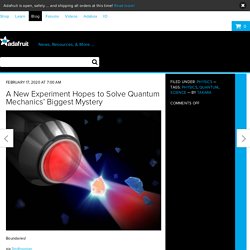
Via Smithsonian The quantum revolution never truly ended. Beneath the world of classical physics, at the smallest scales, tiny particles don’t follow the usual rules. Particles sometimes act like waves, and vice versa. Sometimes they seem to exist in two places at once. Read more. Stop breadboarding and soldering – start making immediately! Join 16,000+ makers on Adafruit’s Discord channels and be part of the community! Have an amazing project to share? Join us every Wednesday night at 8pm ET for Ask an Engineer! Follow Adafruit on Instagram for top secret new products, behinds the scenes and more CircuitPython – The easiest way to program microcontrollers – CircuitPython.org No comments yet. Sorry, the comment form is closed at this time. Quantum interference observed in real time: Extreme UV-light spectroscopy technique.
A team headed by Prof.
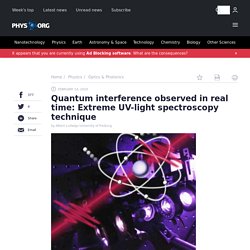
Dr. Frank Stienkemeier and Dr. Lukas Bruder from the Institute of Physics at the University of Freiburg has succeeded in observing in real-time ultrafast quantum interferences—in other words the oscillation patterns—of electrons which are found in the atomic shells of rare gas atoms. They managed to observe oscillations with a period of about 150 attoseconds—an attosecond is a billionth of a billionth of a second.
To this end, the scientists excited rare gas atoms with specially prepared laser pulses. Sciencealert. Scientists have managed to get two quantum memories entangled over 50 kilometres (31 miles) of fibre optic cables, almost 40 times the previous record.

This achievement makes the idea of a super-fast, super-secure quantum internet a much more plausible one. Quantum communication relies on quantum entanglement, or what Einstein called 'spooky action at a distance': where two particles become inextricably linked and reliant on each other, even if they're not in the same place. Quantum memory is the quantum equivalent of classical computing memory – the ability to store quantum information and keep it for a later time – and if we're going to get to the stage where quantum computers are actually practical and useful, getting this fixed memory working is an important part.
As far as photon (light) particle entanglement goes, we've managed it over empty space and optic fibres at large distances in the past, but adding quantum memory makes the process much more complicated. Levitating sand escapes classical world, enters quantum ground state. How big can something get and still display quantum behavior?

It's a fundamental question in physics, and it gets at the nature of reality itself. All sorts of weird behavior goes on in the quantum world: particles behave like they're in two places at once, there are limits to how certain we can be of where things are, and so on. This tiny glass bead has been quantum chilled to near absolute zero. By Leah Crane Kahan Dare, Lorenzo Magrini, Yuriy Coroli, University of Vienna.
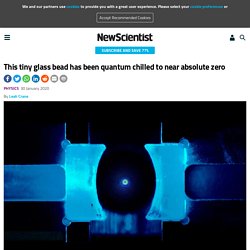
5 Big Ideas for Making Fusion Power a Reality. The joke has been around almost as long as the dream: Nuclear fusion energy is 30 years away...and always will be.
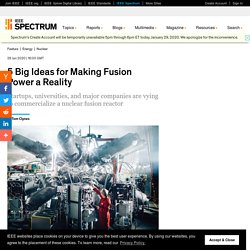
But now, more than 80 years after Australian physicist Mark Oliphant first observed deuterium atoms fusing and releasing dollops of energy, it may finally be time to update the punch line. Over the past several years, more than two dozen research groups—impressively staffed and well-funded startups, university programs, and corporate projects—have achieved eye-opening advances in controlled nuclear fusion. They’re building fusion reactors based on radically different designs that challenge the two mainstream approaches, which use either a huge, doughnut-shaped magnetic vessel called a tokamak or enormously powerful lasers. What’s more, some of these groups are predicting significant fusion milestones within the next five years, including reaching the breakeven point at which the energy produced surpasses the energy used to spark the reaction.
Quantum computers offer another look at classic physics concepts. "Think what we can do if we teach a quantum computer to do statistical mechanics," posed Michael McGuigan, a computational scientist with the Computational Science Initiative at the U.S.
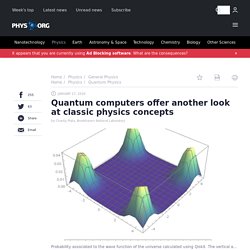
Department of Energy's Brookhaven National Laboratory. At the time, McGuigan was reflecting on Ludwig Boltzmann and how the renowned physicist had to vigorously defend his theories of statistical mechanics. Boltzmann, who proffered his ideas about how atomic properties determine physical properties of matter in the late 19th century, had one extraordinarily huge hurdle: atoms were not even proven to exist at the time. How to measure a single quantum spin in a rapidly rotating diamond. A new twist on quantum communication in fiber. New research done at the University of the Witwatersrand in Johannesburg, South Africa, and Huazhang University of Science and Technology in Wuhan, China, has exciting implications for secure data transfer across optical fiber networks.
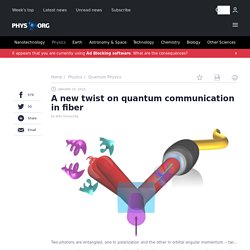
The team have demonstrated that multiple quantum patterns of twisted light can be transmitted across a conventional fiber link that, paradoxically, supports only one pattern. Quantum technique can verify solutions to huge class of problems. Computer scientists’ daydreams have revealed the power of quantum mechanics.
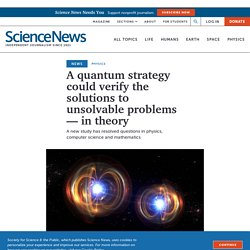
Imagine meeting omniscient beings who claim to have the solution to a complex problem that no computer could ever solve. You’d probably be at a loss to check the answer. But now, computer scientists report that quantum mechanics provides a way to quickly verify the solutions to an incredibly broad class of problems, including some that are impossible to solve in the first place. Although the result doesn’t have obvious practical applications, its theoretical ramifications have had a ripple effect, answering unsolved questions in physics and mathematics, scientists report in a paper posted January 13 at arXiv.org. “It has so many implications for all these areas. In computer science, some problems are difficult to solve but have solutions that are easy to check. Sign Up For the Latest from Science News.
How Pi Connects Colliding Blocks to a Quantum Search Algorithm. What do the digits of pi, colliding blocks and quantum search algorithms have in common?
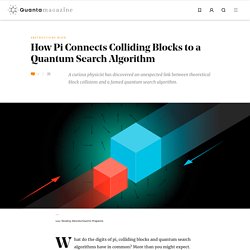
More than you might expect. Two playful papers, one from 2003 and one from last month, provide the links between them. Together, they connect the worlds of dynamics, geometry and quantum computation, highlighting how even the most abstract math puzzles can have surprising physical relevance. Block It Out. Physicists Finally Observe a Link Between Quantum Criticality And Entanglement.
We know that the realm of quantum physics is science operating at a mind-bogglingly small scale, thus watching quantum interactions happen is always exciting. Now, physicists have managed to observe billions upon billions of entangled electrons passing through a metal film. The film is a mix of ytterbium, rhodium and silicon, and is what's known as a 'strange metal', one that doesn't act as expected at very low temperatures.
"With strange metals, there is an unusual connection between electrical resistance and temperature," explained physicist Silke Bühler-Paschen from Vienna University of Technology in Austria. How sensitive can a quantum detector be? Quantum physics is moving out of the laboratory and into everyday life. Despite headline results about quantum computers solving problems impossible for classical computers, technical challenges are standing in the way of getting quantum physics into the real world. New research published in Nature Communications from teams at Aalto University and Lund University could provide an important tool in this quest. Colloidal quantum dot laser diodes are just around the corner.
Los Alamos scientists have incorporated meticulously engineered colloidal quantum dots into a new type of light emitting diodes (LEDs) containing an integrated optical resonator, which allows them to function as lasers. These novel, dual-function devices clear the path towards versatile, manufacturing-friendly laser diodes. The technology can potentially revolutionize numerous fields from photonics and optoelectronics to chemical sensing and medical diagnostics. "This latest breakthrough along with other recent advances in quantum dot chemistry and device engineering that we have achieved suggest that laser diodes assembled from solution may soon become a reality," said Victor Klimov, head of the quantum dot group at Los Alamos National Laboratory. How to verify that quantum chips are computing correctly. In a step toward practical quantum computing, researchers from MIT, Google, and elsewhere have designed a system that can verify when quantum chips have accurately performed complex computations that classical computers can't.
Quantum chips perform computations using quantum bits, called "qubits," that can represent the two states corresponding to classic binary bits—a zero or one—or a "quantum superposition" of both states simultaneously. The unique superposition state can enable quantum computers to solve problems that are practically impossible for classical computers, potentially spurring breakthroughs in material design, drug discovery, and machine learning, among other applications. Full-scale quantum computers will require millions of qubits, which isn't yet feasible. In the past few years, researchers have started developing "Noisy Intermediate Scale Quantum" (NISQ) chips, which contain around 50 to 100 qubits.
Why Should Non-Physicists Learn About Quantum Mechanics? I was asked to do a presentation last week for the Union College Academy for Lifelong Learning (UCALL), an adult-education program at the college, as part of series about faculty who have published books. This ended up being two hours of mostly Q&A about how a silly blog post featuring an imaginary conversation with a talking dog ended up launching a sort of second career in writing books about physics aimed at a non-scientific audience. In the course of this, somebody noted that my first book was about quantum physics and asked the deliberately provocative question “Why is it important for people who aren’t scientists and aren’t going to become scientists to learn something about quantum mechanics?” Influential electrons? Physicists uncover a quantum relationship. Wave physics as an analog recurrent neural network. Analog machine learning hardware offers a promising alternative to digital counterparts as a more energy efficient and faster platform.
Wave physics based on acoustics and optics is a natural candidate to build analog processors for time-varying signals. Wave physics as an analog recurrent neural network. 'Superdiamond' carbon-boron cages can trap and tap into different properties. A long-sought-after class of "superdiamond" carbon-based materials with tunable mechanical and electronic properties was predicted and synthesized by Carnegie's Li Zhu and Timothy Strobel. Their work is published by Science Advances.
Carbon is the fourth-most-abundant element in the universe and is fundamental to life as we know it. It is unrivaled in its ability to form stable structures, both alone and with other elements. Unexpected twist in a quantum system. Scientists observe ultrafast birth of radicals. An international team led by Argonne has visualized the elusive, ultrafast proton transfer process following the ionization of water. Understanding how ionizing radiation interacts with water—like in water-cooled nuclear reactors and other water-containing systems—requires glimpsing some of the fastest chemical reactions ever observed.
Levitated Nanoparticle Goes Quantum. Combining Quantum Physics and Biology to Improve Enzyme Activity Measurements. Combining Quantum Physics and Biology to Improve Enzyme Activity Measurements. Pair of Civil Servants Rewrite Quantum Mechanics in Their Spare Time. No, We Still Can't Use Quantum Entanglement To Communicate Faster Than Light. Chris Monroe, University of Maryland One of the most fundamental rules of physics, undisputed since Einstein first laid it out in 1905, is that no information-carrying signal of any type can travel through the Universe faster than the speed of light. Particles, either massive or massless, are required for transmitting information from one location to another, and those particles are mandated to travel either below (for massive) or at (for massless) the speed of light, as governed by the rules of relativity.
Since the development of quantum mechanics, however, many have sought to leverage the power of quantum entanglement to subvert this rule, devising clever schemes to attempt to transmit information to "cheat" relativity and communicate faster-than-light after all. No, We Still Can't Use Quantum Entanglement To Communicate Faster Than Light. Superconductor or not? Exploring the identity crisis of this weird quantum material. Northeastern researchers have used a powerful computer model to probe a puzzling class of copper-based materials that can be turned into superconductors.
Their findings offer tantalizing clues for a decades-old mystery, and a step forward for quantum computing. The ability of a material to let electricity flow comes from the way electrons within their atoms are arranged. Depending on these arrangements, or configurations, all materials out there are either insulators or conductors of electricity. But cuprates, a class of mysterious materials that are made from copper oxides, are famous in the scientific community for having somewhat of an identity issue that can make them both insulators and conductors. Under normal conditions, cuprates are insulators: materials that inhibit the flow of electrons.
A quantum breakthrough brings a technique from astronomy to the nano-scale. The Quantum World May Have a Favorite Flavor, Tantalizing Results Suggest. A Quantum Physicist Recommends The ‘Rule of Three’ To Simplify Complex Ideas. 8723dd96 2ffc 43e5 adc3 e6f2e22d6031. Rewriting quantum mechanics in their spare time. The experimental demonstration of a spin quantum heat engine.
Quantum computing : Solving problems beyond the power of classical computing. Quantum Computing Breakthrough: Silicon Qubits Interact at Long-Distance. Quantum Teleportation Reported in a Qutrit For The First Time. Quantum Teleportation Reported in a Qutrit For The First Time. Scientists Catch a Quantum Jump as It Happens. New boson appears in nuclear decay, breaks standard model. No, Scientists Will Never Be Able To Remove The Empty Space From Atoms. Heat Energy Has Leapt Across an Empty Vacuum Thanks to a Weird Quantum Effect. New technology improves gravitational wave detectors by cutting quantum noise. Google’s quantum supremacy algorithm has found its first practical use. Major Quantum Achievement Lets Physicists 'See' Gravitational Waves From Deeper in the Universe. Do We Live in a Quantum World? Google Scientists Are Using Quantum Computers to Study Wormholes. Neutron dripline extended to fluorine and neon isotopes.
The mystery of the mass of the neutrino could soon be solved. Astroboffins spot the most energetic photons yet from gamma ray burst – and here's hoping Earth is right in the way of the next one. Pushing the Boundaries in Quantum Electronics. Quantum physics: Our study suggests objective reality doesn't exist. Quantum mechanics gets stern challenge from single silicon ion. Quantum mechanics gets stern challenge from single silicon ion. New research synthesizes different aspects of causality in quantum field theory. Quantum Computer Made from Photons Achieves a New Record. These Weirdo Stellar Corpses Have Creamy Centers Filled with Exotic Quantum Liquids.
Intense Isotope Beam Used to Confirm a New ‘Magic Number’ for Neutrons. New research finding gives valleytronics a boost. Researchers create blueprint for 'quantum battery' that doesn't lose charge. This Is Why The Speed Of Gravity Must Equal The Speed Of Light. Excitons will shape the future of electronic devices. Samsung Invests in Google, Amazon-Backed 'Trapped Ion' Quantum Computer Startup.